Step into the captivating world of backyard aquaponics, where fish and plants dance in harmony, creating a self-sustaining ecosystem that nourishes both your palate and the planet. This innovative practice combines the art of fish farming with the beauty of plant cultivation, offering a myriad of benefits that will transform your backyard into a vibrant oasis of sustainability and abundance.
Backyard aquaponics not only provides a fresh and organic source of food but also promotes environmental stewardship. By recycling water and nutrients, this closed-loop system minimizes waste and conserves precious resources. Embracing backyard aquaponics empowers you to cultivate a thriving ecosystem that delights the senses and nurtures a deep connection with nature.
Introduction to Backyard Aquaponics
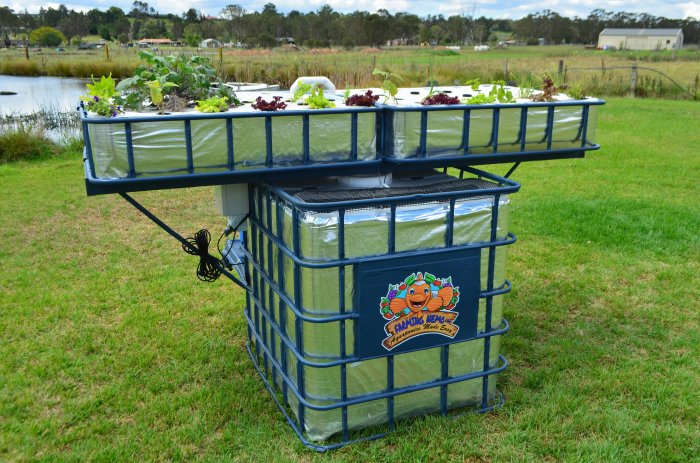
Backyard aquaponics is a sustainable and efficient food production system that combines fish farming (aquaculture) with plant cultivation (hydroponics). This integrated approach allows for the symbiotic relationship between fish and plants, creating a closed-loop ecosystem.
Aquaponics offers numerous benefits for backyard enthusiasts, including increased food security, efficient use of space, and environmental sustainability. By combining fish and plant production, backyard aquaponics provides a reliable source of fresh, nutrient-rich food while minimizing water consumption and waste generation.
Designing a Backyard Aquaponics System
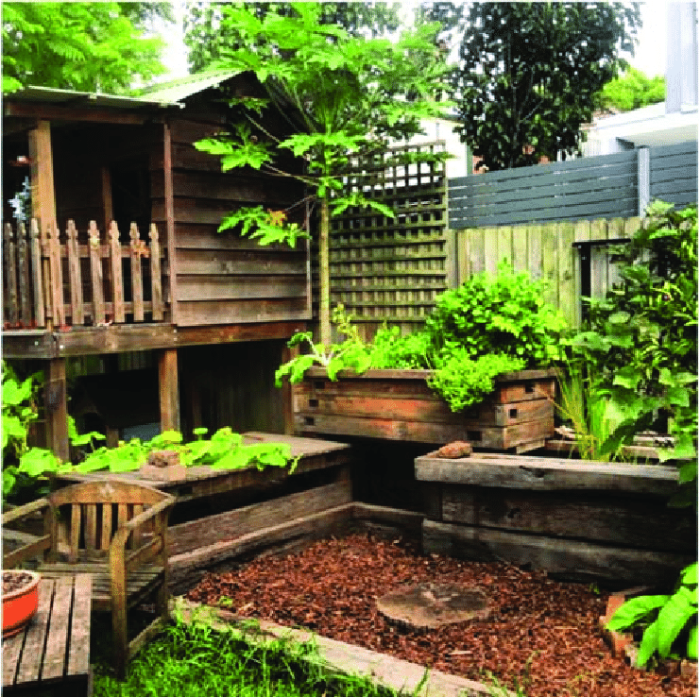
Designing a backyard aquaponics system is a rewarding experience that can provide you with fresh, organic produce and fish. Here’s a step-by-step guide to help you get started:
Tank Selection
The first step is to choose the right tank for your system. The size of the tank will depend on the number of fish you want to raise and the amount of space you have available. There are two main types of tanks used in aquaponics: fish tanks and grow beds.
- Fish tanksare typically made of fiberglass or plastic and are used to house the fish. They should be large enough to provide the fish with plenty of space to swim and grow.
- Grow bedsare used to grow the plants. They can be made of a variety of materials, such as wood, plastic, or metal. Grow beds should be deep enough to provide the plants with adequate root space.
Plant Selection
The next step is to choose the right plants for your system. There are many different types of plants that can be grown in aquaponics, so it’s important to choose plants that are compatible with your fish and your climate.
- Leafy greens, such as lettuce, spinach, and kale, are a good choice for beginners because they are easy to grow and can tolerate a wide range of water conditions.
- Herbs, such as basil, oregano, and thyme, are also a good choice for aquaponics. They can add flavor to your food and help to keep your fish healthy.
- Fruits and vegetables, such as tomatoes, cucumbers, and peppers, can also be grown in aquaponics, but they require more care and attention than leafy greens and herbs.
Water Circulation
The final step is to set up the water circulation system. The water circulation system is responsible for moving the water from the fish tank to the grow beds and back again. There are two main types of water circulation systems: gravity-fed systems and pump-fed systems.
- Gravity-fed systemsuse the force of gravity to move the water from the fish tank to the grow beds. This type of system is simple to set up and maintain, but it requires that the fish tank be located higher than the grow beds.
- Pump-fed systemsuse a pump to move the water from the fish tank to the grow beds. This type of system can be used to circulate water over long distances or to lift the water to a higher elevation.
Plant Selection and Cultivation in Backyard Aquaponics

Plant selection is crucial for a successful backyard aquaponics system. The plants should be compatible with the fish species and the available space, and they should provide a good yield. Some of the most popular plants for backyard aquaponics include vegetables, herbs, and fruits.
Backyard aquaponics can be a great way to grow your own food and connect with nature. But if you’re not careful, you may also be inviting some unwanted guests into your backyard. Spiders are common pests in aquaponics systems, and they can be a nuisance to both you and your plants.
If you’re looking for a natural way to get rid of spiders in your backyard aquaponics system, there are a few things you can do. First, try to identify the type of spider you’re dealing with. Once you know what type of spider you’re dealing with, you can research specific methods for getting rid of them.
For example, some spiders are attracted to light, so you can try turning off your lights at night to deter them. Others are attracted to water, so you can try to keep your aquaponics system as dry as possible. With a little research and effort, you can get rid of spiders in your backyard aquaponics system and enjoy your fresh produce without any unwanted guests.
Vegetables
Vegetables are a great choice for backyard aquaponics because they are easy to grow and provide a high yield. Some of the most popular vegetables for aquaponics include tomatoes, peppers, cucumbers, lettuce, and basil. These plants are all relatively easy to grow and can be grown in a variety of different systems.
Backyard aquaponics, a sustainable way to grow your own food, can be even more rewarding when you attract squirrels to your backyard. These playful creatures love to feast on the insects that thrive in aquaponics systems, helping to keep your plants healthy and pest-free.
To attract squirrels, try setting up a squirrel feeder filled with nuts and seeds. Their presence will not only add a touch of charm to your backyard but also enhance the balance of your aquaponics ecosystem.
Herbs
Herbs are another good choice for backyard aquaponics. They are easy to grow and can be used to flavor food or make teas. Some of the most popular herbs for aquaponics include mint, basil, cilantro, and rosemary. These plants are all relatively easy to grow and can be grown in a variety of different systems.
Fruits, Backyard aquaponics
Fruits are a bit more challenging to grow in backyard aquaponics than vegetables or herbs, but they can be a great addition to any system. Some of the most popular fruits for aquaponics include strawberries, blueberries, and raspberries. These plants are all relatively easy to grow and can be grown in a variety of different systems.
Plant Selection Tips
When selecting plants for your backyard aquaponics system, there are a few things to keep in mind. First, you should consider the size of your system. If you have a small system, you will need to choose plants that are relatively small and compact.
Backyard aquaponics is a great way to grow your own food and save money on groceries. However, one of the challenges of backyard aquaponics is keeping animals from digging holes in your yard. Animals can dig holes to get to the water in your aquaponics system, or they can dig up your plants.
If you’re having trouble with animals digging holes in your yard, there are a few things you can do to stop them. You can try using these methods , or you can try building a fence around your aquaponics system.
Once you’ve stopped the animals from digging holes in your yard, you can enjoy the benefits of backyard aquaponics without having to worry about your plants or your water supply.
Second, you should consider the amount of sunlight your system receives. If you have a system that receives a lot of sunlight, you can grow a wider variety of plants. Finally, you should consider the pH of your water. Some plants are more tolerant of high or low pH levels than others.
Planting Techniques
Once you have selected your plants, you will need to plant them in your system. There are a few different ways to plant in an aquaponics system. The most common method is to use a grow bed. Grow beds are typically made of plastic or metal and are filled with a growing medium such as gravel or clay pebbles.
The plants are then planted in the grow bed and the roots are allowed to grow down into the water. Another method of planting in an aquaponics system is to use floating rafts. Floating rafts are made of a lightweight material such as polystyrene or foam and are placed on the surface of the water.
The plants are then planted in the rafts and the roots are allowed to grow down into the water.
Nutrient Management
The nutrients in an aquaponics system come from the fish waste. The fish waste is broken down by bacteria into nutrients that the plants can use. The amount of nutrients in the water will vary depending on the number of fish in the system and the amount of food they are fed.
It is important to monitor the nutrient levels in the water and adjust the feeding schedule accordingly. If the nutrient levels are too low, the plants will not grow properly. If the nutrient levels are too high, the plants can become stunted or even die.
Water Management in Backyard Aquaponics
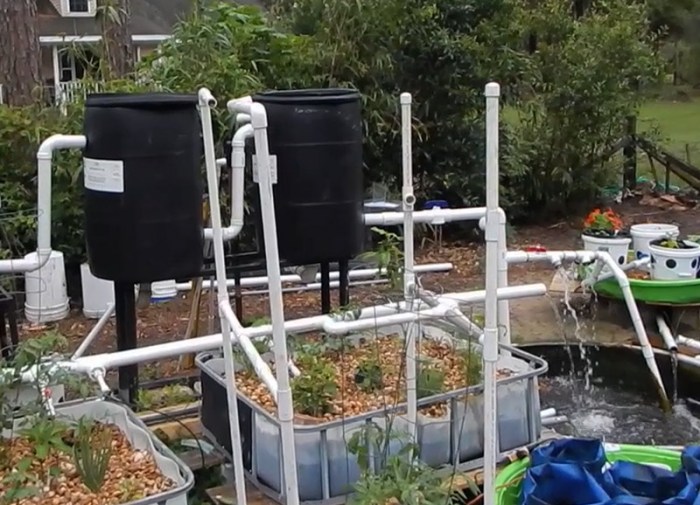
Maintaining optimal water quality is crucial in backyard aquaponics, as it directly impacts the health of both fish and plants. Regular monitoring and maintenance of water parameters are essential to ensure a thriving system.
Key water quality parameters to monitor include:
- pH: Ideal range for most aquaponics systems is 6.5-7.5.
- Temperature: Optimal temperature for fish and plants varies depending on species, but generally between 65-85°F (18-29°C).
- Ammonia: Toxic to fish at high levels, should be kept below 1 ppm.
- Nitrite: Also toxic to fish, should be kept below 0.5 ppm.
- Nitrate: Non-toxic to fish, but excessive levels can inhibit plant growth.
Water quality can be maintained through various filtration techniques:
Mechanical Filtration
Removes physical particles, such as fish waste and uneaten food, using filters like screens, settling tanks, or vortex filters.
Biological Filtration
Utilizes beneficial bacteria to convert toxic ammonia and nitrite into less harmful nitrate. This can be achieved through biofilters, such as moving bed filters or trickling filters.
Chemical Filtration
Involves the use of chemical media, such as activated carbon, to remove dissolved contaminants and impurities.
Troubleshooting Common Issues in Backyard Aquaponics
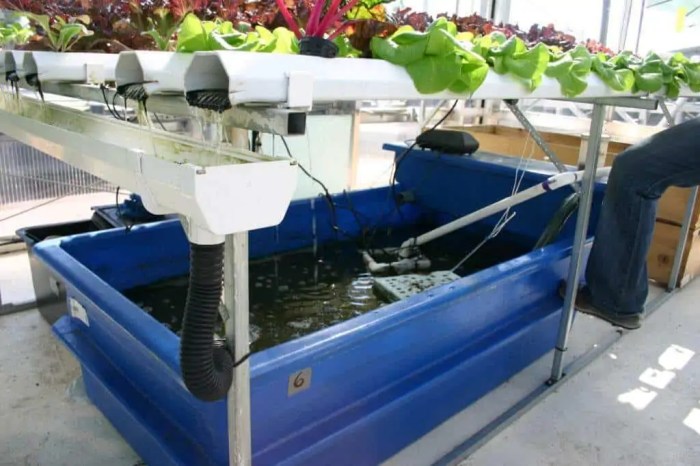
Backyard aquaponics systems, while rewarding, can sometimes encounter challenges. Identifying and resolving these issues promptly is crucial for maintaining a healthy and productive system. Here are some common problems and solutions to help you troubleshoot:
Algae Growth
Algae growth can become excessive in aquaponics systems, affecting water quality and plant health. Causes include excessive sunlight, nutrient imbalances, and poor water circulation. To combat algae, consider:
- Shading the system to reduce sunlight exposure
- Balancing nutrient levels by adjusting fish feed or adding plants
- Improving water circulation using pumps or aerators
Nutrient Deficiencies
Nutrient deficiencies can occur due to insufficient fish waste, plant uptake, or nutrient leaching. Symptoms include stunted plant growth, yellowing leaves, and poor fish health. To address deficiencies:
- Increase fish stocking density or feed more frequently
- Add nutrient-rich supplements like fish emulsion or seaweed extract
- Prevent nutrient leaching by using slow-release fertilizers or mulching
Fish Diseases
Fish diseases can be caused by bacteria, parasites, or environmental factors. Symptoms include lethargy, loss of appetite, and skin lesions. To prevent and treat diseases:
- Maintain optimal water quality through filtration and aeration
- Quarantine new fish before introducing them to the system
- Treat diseases promptly with appropriate medications or natural remedies
Outcome Summary: Backyard Aquaponics
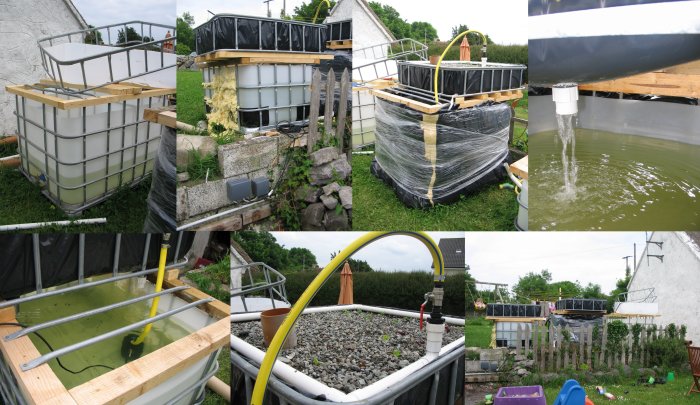
As you delve deeper into the world of backyard aquaponics, you’ll discover a wealth of knowledge and practical tips to guide your journey. From selecting the right fish species to mastering plant cultivation techniques, the possibilities are endless. Embrace the challenges, learn from your experiences, and witness the transformative power of this sustainable practice.
Backyard aquaponics is not just a hobby; it’s a lifestyle that nourishes your body, mind, and the planet, one delicious bite at a time.